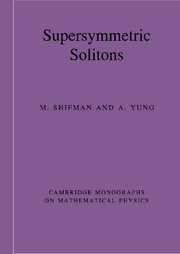Book contents
- Frontmatter
- Contents
- Acknowledgments
- List of abbreviations
- 1 Introduction
- I SHORT EXCURSION
- II LONG JOURNEY
- Introduction to Part II
- 4 Non-Abelian strings
- 5 Less supersymmetry
- 6 Non-BPS non-Abelian strings
- 7 Strings on the Higgs branches
- 8 Domain walls as D-brane prototypes
- 9 Wall-string junctions
- 10 Conclusions
- Appendix A Conventions and notation
- Appendix B Many faces of two-dimensional supersymmetric CP(N – 1) model
- Appendix C Strings in N = 2 SQED
- References
- Index
- Author index
8 - Domain walls as D-brane prototypes
from II - LONG JOURNEY
Published online by Cambridge University Press: 28 July 2009
- Frontmatter
- Contents
- Acknowledgments
- List of abbreviations
- 1 Introduction
- I SHORT EXCURSION
- II LONG JOURNEY
- Introduction to Part II
- 4 Non-Abelian strings
- 5 Less supersymmetry
- 6 Non-BPS non-Abelian strings
- 7 Strings on the Higgs branches
- 8 Domain walls as D-brane prototypes
- 9 Wall-string junctions
- 10 Conclusions
- Appendix A Conventions and notation
- Appendix B Many faces of two-dimensional supersymmetric CP(N – 1) model
- Appendix C Strings in N = 2 SQED
- References
- Index
- Author index
Summary
D branes are extended objects in string theory on which strings can end [10]. Moreover, the gauge fields are the lowest excitations of open superstrings, with the endpoints attached to D branes. SU(N) gauge theories are obtained as a field-theoretic reduction of a string theory on the world volume of a stack of N D branes.
Our task is to see how the above assertions are implemented in field theory. We have already thoroughly discussed field-theoretic strings. Solitonic objects of the domain wall type were also extensively studied in supersymmetric gauge theories in 1+3 dimensions. The original impetus was provided by the Dvali-Shifman observation [11] of the critical (BPS-saturated) domain walls in N = 1 gluodynamics, with the tension scaling as. N Λ The peculiar N dependence of the tension prompted [12] a D-brane interpretation of such walls. Ideas as to how flux tubes can end on the BPS walls were analyzed [213] at the qualitative level shortly thereafter. Later on, BPS-saturated domain walls and their junctions with strings were discussed [214, 215] in a more quantitative aspect in N = 2 sigma models. Some remarkable parallels between field-theoretical critical solitons and the D-brane string theory construction were discovered.
In this and subsequent chapters we will review the parallel found between the field-theoretical BPS domain walls in gauge theories and D branes/strings. In other words, we will discuss BPS domain walls with the emphasis on localization of the gauge fields on their world volume.
- Type
- Chapter
- Information
- Supersymmetric Solitons , pp. 196 - 208Publisher: Cambridge University PressPrint publication year: 2009



